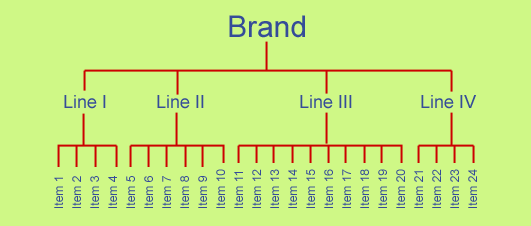

|
Product Items, Lines, and Brands |
Copyright 2006
Cornell
University.
All rights reserved.
Product Items, Lines, and Brands
The goal is to add products that coordinate with the first prototype design to develop a brand and line of products that customers can readily identify. The product hierarchy diagram below illustrates this concept.
Product Hierarchy Model You can start at the bottom of the hierarchy with one idea that you want to transform into a commercial product. For example, let's say that you are developing a shirt for high school-aged young men and women from a new fabric that changes colors as your body warms it. It is called the chameleon shirt. The value proposition (covered in the Entrepreneurship module) is its innovative use of materials to create a dynamic shirt color. After the chameleon shirt has been launched successfully, you need to create a second product to sustain and grow the business. For example:
Let's consider each of the four options in relation to the product hierarchy model. Creating a second shirt design from the same fabric begins to build a line of items. A line of products, in this case the chameleon shirt line, usually contains items that:
You can also build another line of items by choosing a second innovative material for a shirt. The line will still be marketed as a single product type (i.e., shirt), but the items in the line will vary by material rather than shirt style, and go by a different name. A third option will develop several lines of related items across several product types for the high school market. For example, the chameleon fabric could be used for shirts, pants, gloves, and hats. The lines will be marketed to the same target market but across several product types, making it a collection. It could be called the chameleon collection. The pattern development and production would become more complicated because the design requirements for each item would vary. A final option will build another line based on chameleon fabric for shirts to another target market. The value proposition will be the innovative material in shirts for all ages, providing several distinctive lines in your brand. Although the product type remains the same, the production and marketing strategy may be more complex as size, style, and price may differ. Using these ideas as you build a business will help your long-range business planning. Consider each single item, groups of items as lines, and potential branding opportunities to extend the length of each product's life cycle.
|
 Many entrepreneurs start their businesses with a single design or item. That single item, or SKU (stock-keeping unit), is the building block of their business. Additional items can be added over time.
Many entrepreneurs start their businesses with a single design or item. That single item, or SKU (stock-keeping unit), is the building block of their business. Additional items can be added over time. 